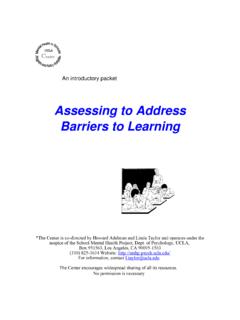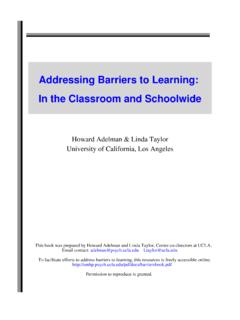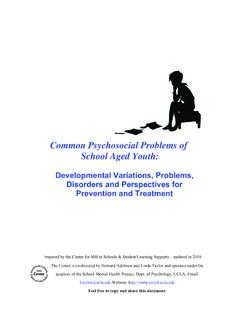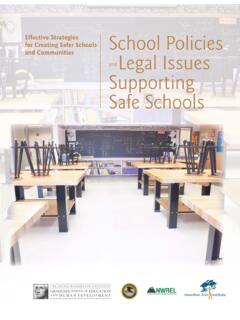Transcription of Barriers to effective curriculum implementation
1 Research in Higher Education Journal Volume 36 Barriers to effective curriculum implementation Erica A. Nevenglosky Walden University Chris Cale Walden University Sunddip Panesar Aguilar University of St. Augustine ABSTRACT An administration of a private school located in the south reported the problem of a lack of curriculum fidelity to a new phonics program, which created a need to identify Barriers preventing full curriculum implementation . Using the concerns-based adoption model (CBAM) as the conceptual framework, this qualitative case study identified concerns and Barriers teachers report when implementing a new curriculum . Data were collected from 10 participants (8 teachers and 2 administrators) through a questionnaire, interviews, and observations. Participants were interviewed to identify any Barriers experienced with curriculum fidelity of a new phonics program. Teachers were observed to determine which components of the curriculum were present in or omitted from their lessons.
2 Participants completed a questionnaire to determine their levels of concern when asked to implement a new curriculum . Results indicated that teachers required additional information before the expected implementations occur and an understanding of demands on their personal time. Common themes showed a desire for professional development (PD), peer-collaboration, and access to curriculum resources, which served as the basis for the project. The resulting project integrated PD to address concerns connected to reoccurring themes. Implications for social change include change at a systematic level by providing administrators with data to support teachers during curriculum changes and substantiation for the benefits of understanding concerns prior to a change for improving curriculum fidelity. Keywords: curriculum , fidelity, phonics, professional development, curriculum changes Copyright statement: Authors retain the copyright to the manuscripts published in AABRI journals.
3 Please see the AABRI Copyright Policy at Research in Higher Education Journal Volume 36 INTRODUCTION Both public and private schools in the United States continue to experience rapid and regular changes in their curricula (McShane & Eden, 2015; National Center for Education Statistics [NCES], 2017). These changes require teachers to possess the skills and knowledge to implement curricula with fidelity (Wiles & Bondi, 2014). Adopting new curricula requires teachers to feel confident in the delivery and purpose of the materials they use in order to ensure accurate implementation (American Institute for Research [AIR], 2016; Early, Rogge, & Deci, 2014). Identifying reasons that support or prevent teachers effective implementation of a new curriculum may provide direction for helping them with curriculum changes. According to Lochner, Conrad, and Graham (2015), teachers are central to whether a curriculum is delivered consistently, effectively, and with efficacy to enable the support of student progress and growth.
4 In a study, the NCES (2017) conducted on curriculum fidelity and professional development, teachers self-reported fidelity rates when implementing an English language learner (ELL) program. The authors, who used a log to rate the level and amount of time spent on using the curriculum as prescribed, found that 16% of participants recorded decreased levels of fidelity, 51% recorded average levels of fidelity, and 30% recorded consistent fidelity of implementation , as prescribed by the curriculum developers. Previous researchers have shown a need to identify the factors that contribute to teacher concerns and which Barriers prevent full curriculum implementation (Lochner et al., 2015). Understanding the Barriers to complete implementation of a new curriculum could provide education administrators with tools to address teacher concerns and could provide vital training for successful implementation (AIR, 2016).
5 DEFINITION OF THE PROBLEM The problem at Southwest Private School (SPS, a pseudonym) is that a new phonics-based curricular program is not being implemented with fidelity, according to the SPS principal (personal communication, May 23, 2016). Administrators have not acted to identify or understand the practices, concerns, and Barriers to curriculum fidelity (SPS principal, personal communication, May 23, 2016). The existing gap in practice is that teachers are not implementing the curriculum faithfully; as a result, which concerns teachers report when implementing a new curriculum remain unknown. This gap extends to a lack of offerings for professional development (PD) and classroom observations to remedy the problem (SPS principal, personal communication, May 23, 2016). In general, implementing curricula consistently supports student growth of knowledge and academic preparedness for the next grade levels (Polikoff & Porter, 2014).
6 At SPS, however, the administration recently purchased a phonics curriculum , but the teachers have chosen not to implement it as directed, thus creating inconsistencies (SPS principal, personal communication, May 23, 2016). Teachers and parents have cited the lack of fidelity in curricular implementation as a contributing factor to the students unpreparedness for the next grade levels, because the curriculum is no longer vertically aligned (SPS headmaster, personal communication, August 31, 2016). Vertical alignment has to do with similarities in instructional practices and the fidelity of curriculum use and implementation between previous and following grade levels (Wiles & Bondi, 2014). With teachers not faithfully implementing the curriculum , it is difficult to determine which objectives are taught before students enter the Research in Higher Education Journal Volume 36 next grade. A need exists to understand the reasons that either support or prevent teachers faithful implementation of a new curriculum .
7 Concerns about the teachers lack of curricular fidelity existed before the purchase of the new phonics curriculum at SPS. The curriculum purchase took place to help remedy the alignment concerns that various stakeholders, including parents and teachers, shared (SPS principal, personal communication, May 23, 2016). The administrators chose the Saxon Phonics and Spelling program (Houghton Mifflin Harcourt, 2017) to replace the Bob Jones phonics program that was previously used in kindergarten through grade 3. The Saxon Phonics and Spelling program (henceforth Saxon ) presents a research-based method focused on phonics, decoding, spelling, and fluency. The design of the program allows for pattern building within the structure of words and sounds to promote greater fluency and transfer of patterns into everyday spelling. The Saxon program differs from the previous program in terms of the different instructional strategies and teaching techniques involved in delivering the curriculum .
8 Previous researchers have asserted that teachers should implement curricula with fidelity to meet various objectives for student preparedness (McShane & Eden, 2015; Stellar, 2016). The results from the NCES study (2017) mentioned above indicated that 80% of teachers who implemented the curriculum with high to moderate fidelity reported significant improvements in teaching practices and strategies useful for supporting student learning. In addition, the literature offers data in support of the need for consistency in using a curriculum for maximum benefit to the students (McNeill, Katsh-Singer, Gonzalez-Howard, & Lopez, 2016). Research on identifying the Barriers to the full implementation of a curriculum is needed. Understanding the Barriers involved would require determining teachers experience when facing a new innovation or change (AIR, 2016). With the 2017 introduction in the United States of the Every Student Succeeds Act, or ESSA (United States Department of Education [USDOE], 2017), state and administrative expectations for accurate and faithful curricular implementation have become paramount for student success, regardless of individual academic needs.
9 Because one of the goals of ESSA (USDOE, 2017) is student preparedness, achieving an understanding of what prevents teachers from faithful curricular implementation will require evaluation to improve student success (USDOE, 2017). Identifying teacher concerns connects to the current proposed study because of the need to understand Barriers that may inhibit teachers when they must implement a new curriculum change. Addressing these concerns both before and during the curriculum - implementation process will increase the success rate by giving administrators the proper tools they need to support teachers through curriculum changes (AIR, 2016). This study also calls attention to possible reasons to explain why full curriculum implementation does not occur, in addition to addressing the Barriers that teachers often report. RESEARCH QUESTIONS The study s research questions (RQs) focus on understanding the reasons that either support or prevent teachers implementation of a new phonics curriculum .
10 The study investigated the teachers experiences and practices with their implementation of the new curriculum : RQ1: What concerns, successes, and Barriers have teachers reported during the implementation of the newly purchased phonics curriculum ? RQ 2: What resources do teachers believe are necessary to achieve a more successful implementation of the new phonics curriculum ? RQ 3: What types of staff support have administrators reported being included before and Research in Higher Education Journal Volume 36 during implementation of the new phonics curriculum ? RQ4: What components of the phonics curriculum do teachers include or omit in their instructional practices? LITERATURE REVIEW To support the purpose of this qualitative case study, an analysis of the literature from current, peer-reviewed studies and articles was conducted to provide further information on the topic. The related literature substantiates the problem and highlights perspectives for understanding the Barriers to complete implementation of new curricula and how teachers view available systems for curriculum support.















